This story takes us to the oldest Swedish immigrant community in Iowa: New Sweden. Like Swede Bend up in Webster County, this Jefferson County locale remains untouched by modern urban development. The countryside remains very much the same as it did in the mid-1800's when our ancestors arrived.
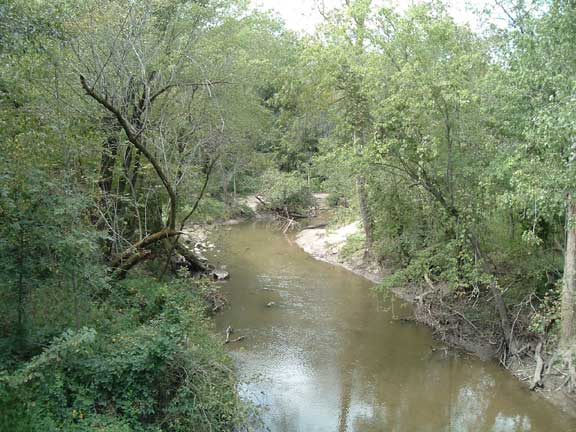
New Sweden's Brush Creek
Nothing preserves the earliest vistas as well as the winding Brush Creek seen above, and no place is more famous and at the same time infamous than its banks, for this was the place where the Swedish Baptists who built the first church of their denomination in America were immersed. Infamous, because even the pastor of the Lutheran congregation was briefly persuaded to join them!
In the mid-1900's, both denominations organized large gatherings at New Sweden to celebrate their pioneering roots there, and by then had written histories for us to read. Interestingly, their stories of New Sweden diverge on some salient points: in most Lutheran accounts Pastor Håwkanson wavers but remains dry; the Baptists have him well under water. Let the reader decide who has the better evidence. For latecomers like the Mission Friends, this is an opportunity to review our own roots as well as to parse the interactions of the earliest immigrant believers.
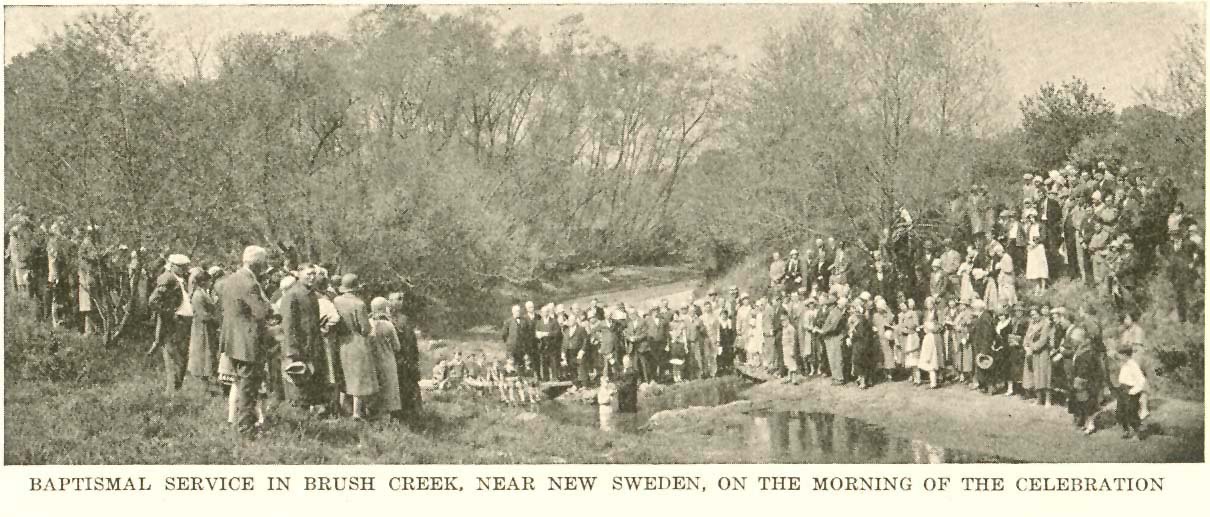
In 1931, Swedish Baptists revisited Brush Creek, 1,500 strong
There is an official highway sign on US 34 west of Mt. Pleasant which indicates an historic Swedish chapel to the north. For whatever reason, this initially missed our attention while living in Iowa, but thanks to the Winquists' guidebook and repeated references to the Peter Cassel immigrant group which spawned Swede Point and Swede Bend, this location came into sharper focus. The colorful stories of three Swedish churches clustered on "the Swedish mile" and the discovery that a significant part of the Swedish Baptist church of our 20-year home at Stromsburg, Nebraska, had come there as a group from New Sweden, added to the interest in this location. The highway department signs have made it easy to find New Sweden, and it is a good thing since it is indeed "tucked away" and unnamed on modern maps.
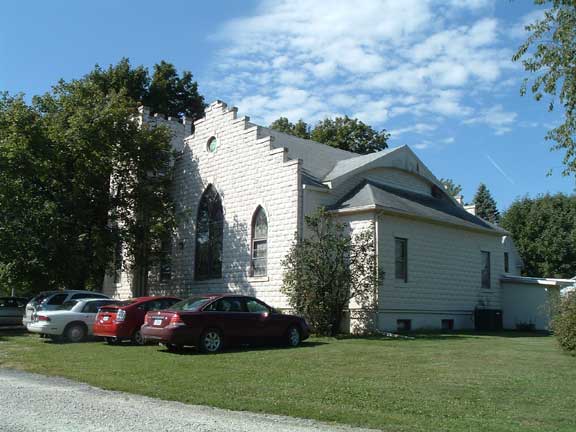
The Swedish Lutheran church in Lockridge
First one comes to the little village of Lockridge, which, in the familiar story seen all over the midwest, the coming of the railroad shifted population from a budding rural village (Four Corners) to the station "on the line" four miles south. Called "Coal Port" on an 1871 map, Lockridge preserves a vintage Augustana church which lays its own claim to being part of the earliest Swedish Lutheran roots. Indeed, with the integration of Augustana into greater Lutheranism in America, the maintenance of their historic New Sweden building has fallen to the Lockridge congregation alone, a task very commendable in the eyes of historians. For many years the Burlington Zephyr and its Amtrak successor have rumbled through Lockridge, oblivious to the history there.
Just a few miles further to the north, Four Corners has not quite disappeared completely; an eating establishment remains at the corner just east of the Swedish mile. During the Baptists' commemorative event mentioned earlier, a then-surviving school and meeting hall provided accommodations. At one time it had the full complement of a village including post office, various businesses and two German churches.
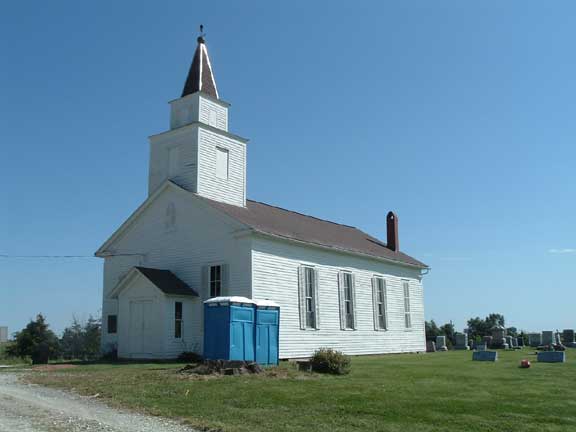
The Swedish Lutheran church; only survivor at New Sweden
It was out in the country, however, where things became really interesting. Travel west from Four Corners past the Baptist cemetery and historical marker on the right (we will return to that story later) and soon the New Sweden Lutheran church built in 1860 appears on the hill on the left side of the road. Parsonage and graveyard are adjacent, and this is the site of the original log church of 1845. In a landscape reminiscent of the Swedish homeland, one can witness here sights which to the immigrant heritage equate with Plymouth Rock for earliest Americans. The oldest Augustana church; the oldest Swedish Baptist site; the third oldest Swedish Methodist site. It is quite a story.
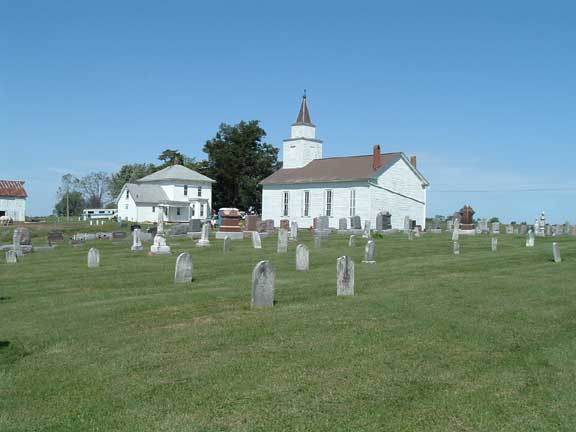
New Sweden today, with parsonage and churchyard, the oldest site
A bronze marker reads "New Sweden Chapel
Lutheran Augustana Synod Centennial 1848-1948
marker erected by the brotherhood of the
Iowa Conference, June 11, 1948"
In 1944 the Lutheran congregation merged with Trinity Lutheran Church in Lockridge and the parish became the First Augustana Lutheran C h u r c h . The hundredth anniversary of the founding of the New Sweden Congregation was held on June 11, 1948, with a jubilee celebration attended by some 2,000 people. Among the guests were Archbishop E r l i n g E i d em and the bishop of Karlstad, A r v i d Runestam, from Sweden, and dignitaries from the Augustana Lutheran Synod.
The leader of the group of emigrants from Kisa, Östergötland to New Sweden was Peter Cassel, a landowner and critic of conditions in Sweden. The intention of the group was to join with the Unonius group in Pine Lake, Wisconsin, but learning of newer opportunities in Iowa, the newcomers changed course. Cassel would continue to promote emigration, and was celebrated both here and in his home country for his assistance to many. Some of the Kisa emigres would travel on northwesterly, up the Des Moines River to Swede Point and Swede Bend where some of the Cassel relatives located.
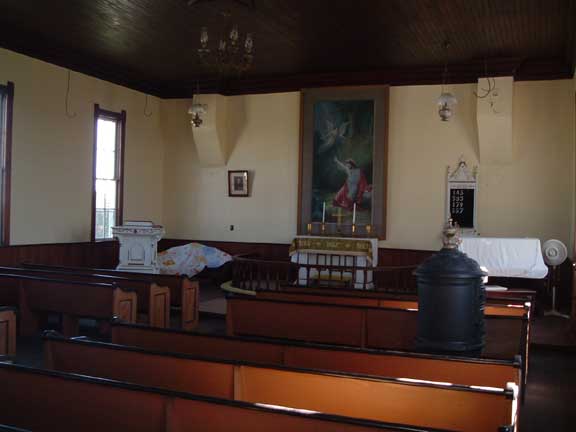
Original furnishings, used now only for special occasions
The early organization of a church proves the religious interest of the group, their log church being built in 1851, but the question of securing a pastor became a problem when Magnus Håwkanson, the only member with some experience and reportedly a disciple of Peter Sellergren in Sweden, was less than enthusiastic about stepping into the role of pastor. (A bit later in his career, Håwkanson would encourage deacon C.A. Björk to lead worship in his absence up in Swede Bend)
Visiting preachers were to become the bane of New Sweden. Unonius was first on the scene, and further eroded Håwkanson's confidence by criticizing him and his church for operating without official sanction. His idea of official sanction harked back to the original New Sweden of the last century on the Delaware, when Swedes were aligned with the Episcopalians.
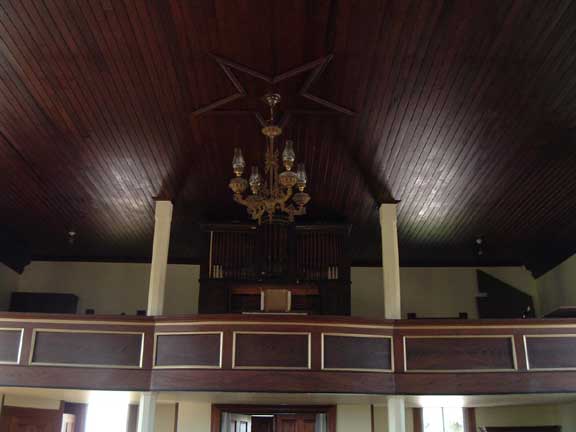
The organ was built by local craftsman John Levendahl in 1861-2
But the new New Sweden was also within the sphere of influence of Jonas Hedstrom at Victoria, Illinois. This aggressive organizer, along with his brother Olof Gustav, whose Bethel ship in New York harbor strategically and effectively welcomed all Swedish immigrants, proclaimed that in America it was Methodism that embodied the religious spirit that all Swedes sought. This message had amazing traction in New Sweden, though the group was taken aback that Hedstrom should be so critical of the worship forms and vestments of clergy familiar to Lutherans. Most observers agree that brother O.G. Hedstrom of the Bethel ship ministry was the more congenial and winsome advocate for Methodism, and we know that the Cassel group had spent time at the Bethel ship enroute to Iowa.
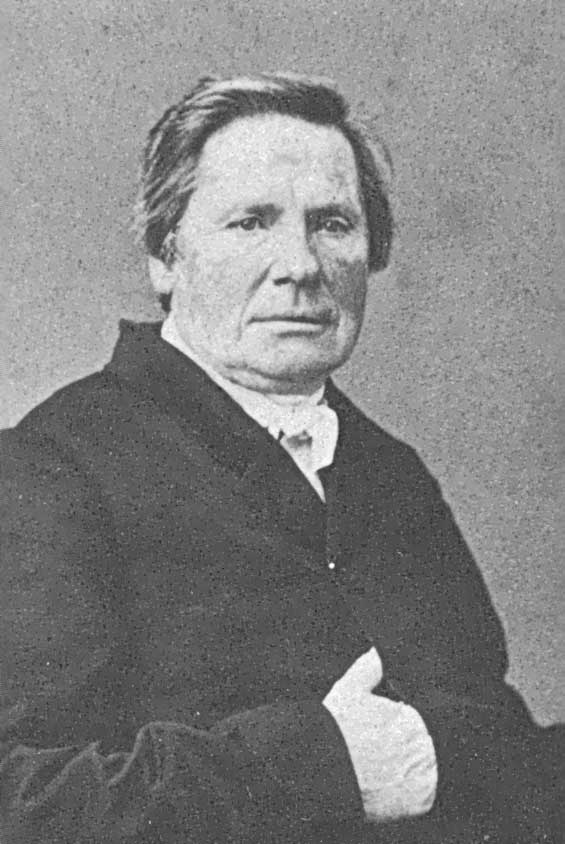
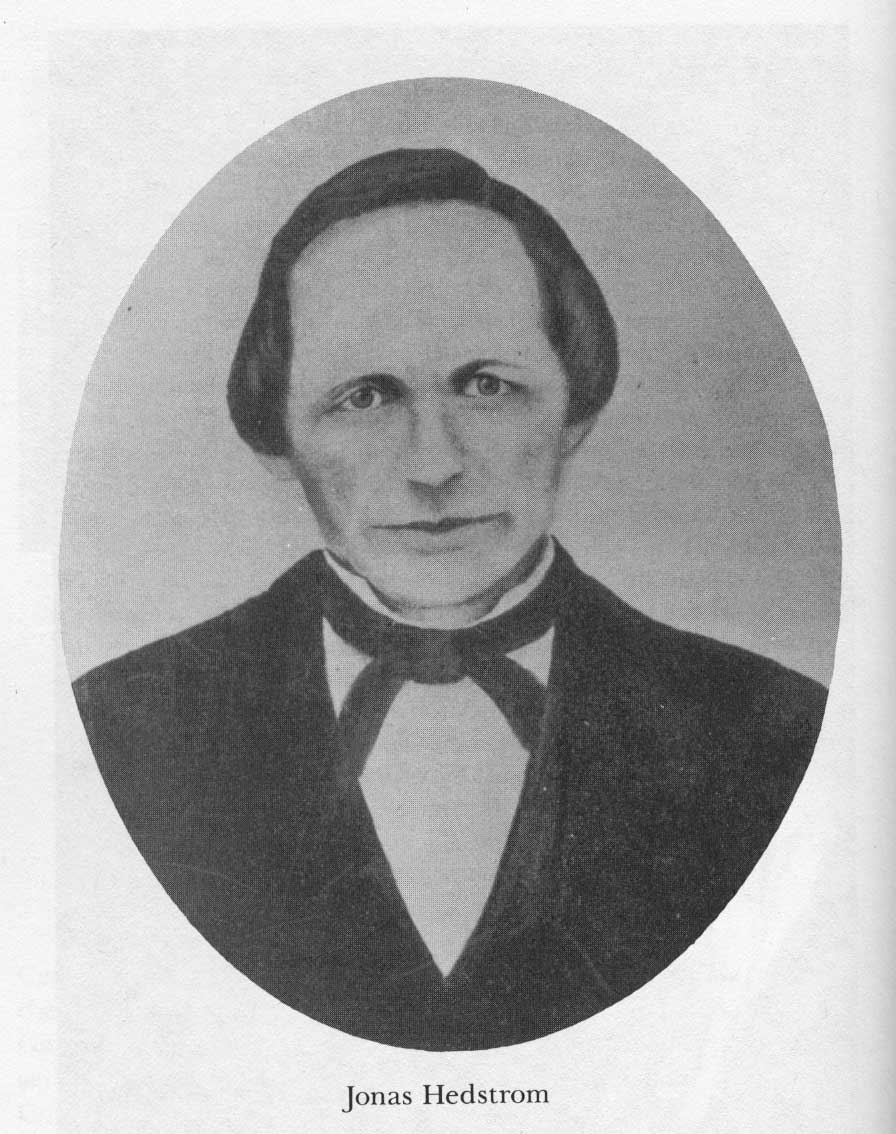
The Hedstrom brothers: O.G. of Bethel Ship and Jonas of Victoria, Illinois
Now upstaged by this new development, Håwkanson's confidence again was shaken and doubly so when learning that two of his leading companions, Cassel and Danielson along with others were ready to heed the Hedstrom message. When some of the Håwkanson faithful resisted, the Methodist party parted company with them and constructed their own house of worship just a quarter mile west along the Swedish mile in 1856. The parting was sudden but permanent.
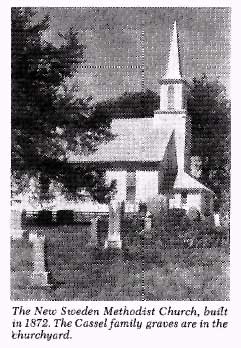
The Swedish Methodist church at New Sweden
Fast forward now to our visit to the historic New Sweden Lutheran church built in 1860 (the railroad had come in 1859). In the foyer lay a recent newspaper with the startling headline: "Fire Destroys New Sweden Methodist Church!" Only months prior to our visit, the century old Methodist church, built on the same site as the original Cassel Methodist church, was no more. It had apparently been the last active congregation on the old Swedish mile, and its adjacent graveyard the resting place of Peter Cassel and a great many of the original New Sweden immigrants.
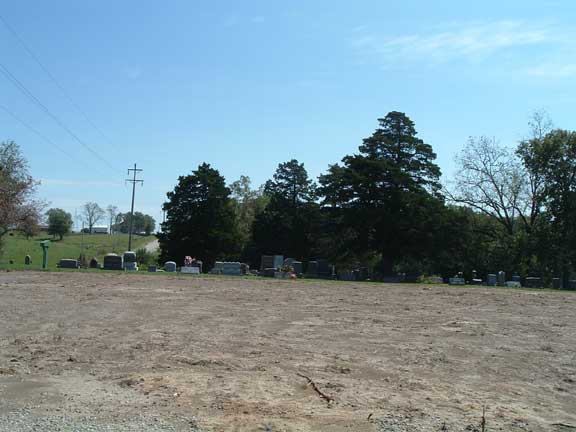
The Methodist site, now erased
Grass had not yet begun to grow on the ugly scar of bare ground left on the Methodists' hill. The graveyard and playground with many mature trees surrounding were a sad reminder of how quickly history can fade away. Much of the story of this congregation also remains hidden from us, for now. It was time to turn back; this was the western end of the "Swedish mile."
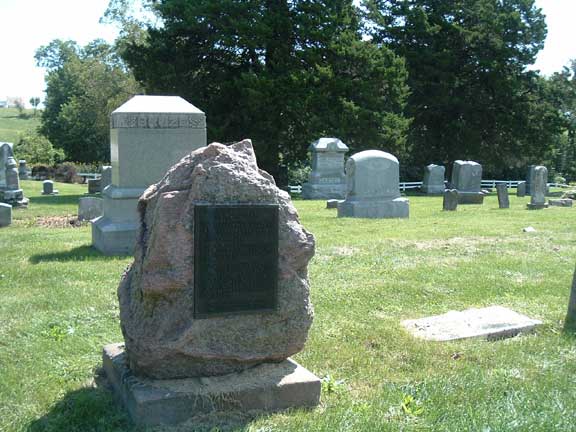
The gravesite of Peter Cassel, with the following inscription:
In 1845 Rev. Peter Cassel led the first company of Swedish emigrants
to establish a permanent colony west of the Mississippi River.
Born in Sweden, October 13, 1790 Died March 4, 1857
Catharine, his wife, born September 3, 1807 Died May 3, 1877
With others he soon planned the organization of a church
which took place on the day of Pentecost in 1850
It was the third Swedish Methodist church in the United States
and he became the first resident pastor.
The two earlier Swedish Methodist churches would have been Hedstrom's Victoria congregation across the river in Illinois, and possibly Galesburg. The Lutheran days are not mentioned.
Before leaving the Methodist site, consider this further information about the historic role played by Peter Cassel:
In commemoration of the first group of Swedish peasants to emigrate and found their own colony in America during the nineteenth century, which originated in Kisa, an emigrant museum has been established there in the old Sundius apothecary shop, where momentos of the emigrants are collected and displayed. The Kisa library houses a collection of 1,370 " A m e r i c a - l e t t e r s . " Between 1845 and 1915, 1,361 persons emigrated from Kisa parish, of which 720 were men and 641 women. In the year 1881 alone, for example, 81 persons emigrated from the parish. The Linköping lodge of the Vasa Order of America and the Kisa Cultural Council hold each year a "Peter Cassel Day" on the Sunday preceding Midsummer.
Returning to the Baptist site, a quarter mile east of the Lutheran church, there is the reminder that more developments remained for the New Sweden immigrants. Håwkanson's Lutheran colleagues, Esbjörn at Andover and later Hasselquist at Galesburg, were striving to find a Lutheran identity in America. Their labors would eventuate in the Scandinavian Augustana Synod in 1860. Early on, one of their most gifted mission preachers was Håwkanson's friend from Sweden, Gustav Palmquist.
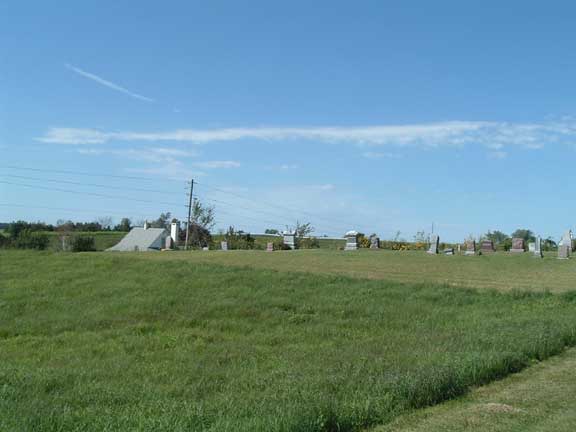
Reminiscent of Sweden; New Sweden's Baptist site and cemetery
The memorial marker is near center where the church stood
Like Cassel, Palmquist was apparently ready to "try something new" in the new land of freedom. Employing the axiom later associated with the Mission Friends, "where is it written?", Palmquist and others began to warm to the idea of "believers' baptism." He remained in the Lutheran camp when visiting New Sweden and points north, but the impact of his joining with the Baptist denomination soon afterwards must have been important in these locations. The Mississippi valley was the hub of Swedish Baptist activity, so ere long its other leaders, Anders Wiberg and F.O. Nilsson came to New Sweden.
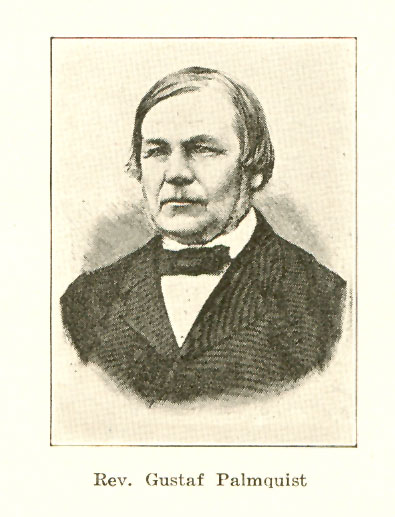
Now another tremor was felt along the Swedish mile. The Baptist movement in Sweden had been stigmatized as separatist and sectarian, though in some ways it lay the ground for the free church movement. In America this stigma dissolved. Some, such as New Sweden Lutherans Olaf "Sailor" Peterson and Peter Carlson may have already had inclinations along Baptist lines. So, when a series of meetings promoting the Baptist cause was held it was one thing that they should switch allegiances. It was quite something else that their long-suffering leader, Magnus Håwkanson, should join them, however briefly. That episode elevated New Sweden to notoriety.
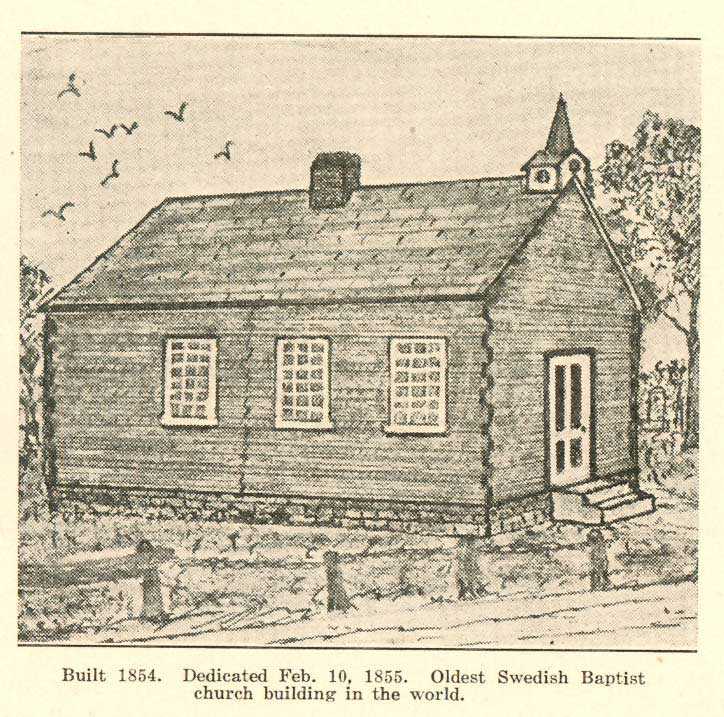
Though earlier congregations came and went, Ahlstrom makes the bold claim seen in the caption
Following the example of the Methodists, the Baptists also raised their own log church one-quarter mile in the other direction from the original church. Though some earlier congregations had been organized, the Swedish Baptists reckon this as their first continuing congregation in America. The monument erected in 1931 attests to this. Schillerstroms and Carlsons are among those resting at the site's cemetery, later shared with a German congregation, though its other leaders are buried at Stromsburg, Nebraska.
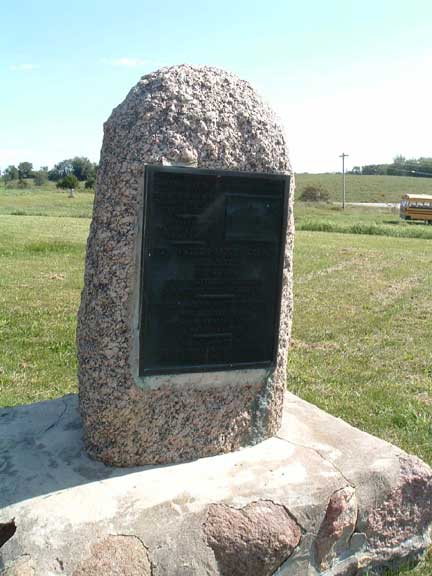
The monument at the Baptist cemetery which reads:
"What Mean Ye By These Stones?" Josh. 4:6-22
First House of Worship in America
Erected by Swedish Baptists
logs cut and hewn from the virgin
forests of these hillsides
NEW SWEDEN BAPTIST CHURCH
Organized May 23, 1854
FIRST TRUSTEES AND DEACONS
Olof Peterson . Gustaf Schillerstrom
PIONEER SWEDISH BAPTIST MINISTERS
IN AMERICA WHO LABORED HERE:
G. Palmquist, A. Wiberg, F.O. Nilsson
A. Norelius, L.L. Frisk
Memorial erected by the Iowa Swedish Baptist
Conference, Dedicated May 17, 1931
Each of the early Swedish American denominations appeared at New Sweden and so historians of each group have focused on events there. Is it possible to reach back and imagine the conditions there without being influenced by subsequent developments? For instance, local New Sweden people remind us early on that these three churches soon began to cooperate in joint ventures including temperance work and even pulpit exchanges. When the Baptist exodus to Stromsburg sapped its membership and the population shifted to Lockridge, their building was utilized by the Lutherans for its school.
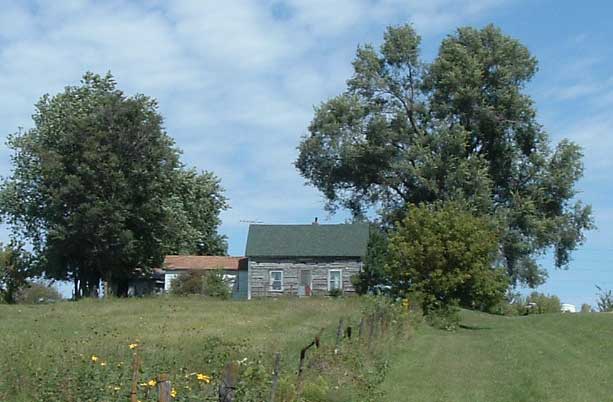
A surviving house near the Baptist site reveals log construction
While the Lutheran faithful took their lumps at New Sweden, one might ask whether the experience prompted overreaction by Hasselquist as president of the Augustana Synod to competitive efforts among the Swedes. Nevertheless, the pattern set by New Sweden was to repeat itself all across the nation. Where there was a Swedish community of any size, there would be Swedish Lutheran, Methodist and Baptist congregations... and later Mission Friends as well.
The summaries above, like most, rely primarily on the writings of Eric Norelius, the Augustana historian who came early to the scene and knew the principal characters. It is instructive to sift through these writings again to see some revealing details. When Norelius describes the New Sweden's initial gatherings for worship under Håwkanson in 1848, he says, "No formal organization took place, but the members looked on themselves as members of a Lutheran congregation as was the custom in Sweden." Considering the subsequent events, one must consider the viewpoint of Cassel descendants that the original group never considered itself to be a Lutheran body. From that perspective, it would be Hasselquist's visit in 1853 which established the original group as Lutheran, at which time a constitution was adopted. Pastor Esbjörn at Andover had also secured a gift from Jenny Lind from which the $300 for New Sweden's 1851 building was distributed. But evidently, many of the group were still "weighing" the merits of Swedish Lutheranism in this new land of freedom.
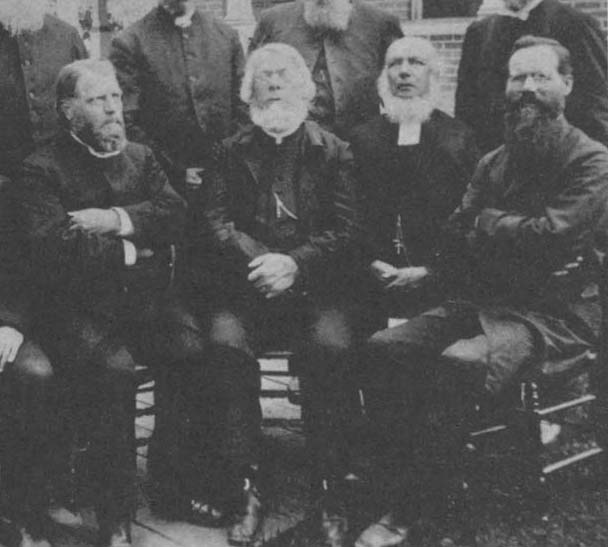
Of Håwkanson, Norelius has this rather startling comment: "He did not intend to devote himself to the task indefinitely, for he was conscious of his weakness and incompetence." That last word has a bite to it. If it has been translated faithfully, it would make our picture of the four pioneer Augustana pastors seated together: Erland Carlsson, Hasselquist, Håwkanson and Norelius, a remarkable one. Perhaps Håwkanson's position a half row back is significant. Hopefully at this advanced age the old pioneers had long forgotten their various entanglements...of which there were many.
Norelius then continues:
"Afterwards came the Swedish Baptist preachers, G. Palmquist, Fr. O. Nilson, A. Norelius and Rundquist, in that order. Through the first two the settlement was torn in conflict on the question of [infant] baptism. The Methodists quieted down and slowly withdrew. But the Lutherans, who had gained confidence in Palmquist by his evangelical sermons before he turned Baptist, were more vulnerable."
This paragraph is remarkable for at least two reasons. Though Anders Norelius is not often mentioned in the early stages of the Baptist movement in New Sweden, Eric Norelius' account has authority since, embarrassingly enough, they were brothers. Secondly, it appears that the Methodists were little affected by the Baptists' preaching! Only the original Lutheran group was "vulnerable." And those who now parted company were no less prominent among the members than the Methodists had been: Charles Carlson and Olaf "Sailor" Peterson had provided the land upon which the original church was built. But the Baptists built their own house of worship and did not contend for the original site. Though Norelius does not mention a visit from Anders Wiberg, one of the most prominent of the early Baptists, we have this account from his own hand:
from A. Wiberg visit to America 1852-3 - archives
In the afternoon, after a walk of half a mile, we reached the Swedish settlement, called "New Sweden." Here, as well as 2 Swedish miles away in and around the city of Fairfield, there are about 300 Swedes. New Sweden has a Lutheran congregation with a pastor and church, for which Jenny Lind had given funding. We stayed with a farmer named Olof Petterson, who had come here in 1847 from Stockholm. When he arrived here he owned $100.00, for which he bought 40 acres and built a socalled log cabin. The year after, he had to work for others to cover his necessary expenses. In 1849 he began seriously to work his farm and has since been on the home place. He has now cleared 12-15 acres of forest land and has purchased 5 more acres of forest. He has torn down his first log cabin and built a larger one with two rooms, as well as necessary outbuildings. He is also well equipped with field implements and household goods, and has a good barn. He is now within a few dollars of being out of debt, and would not sell his real property for $500.00 nor his personal property for $200.00.
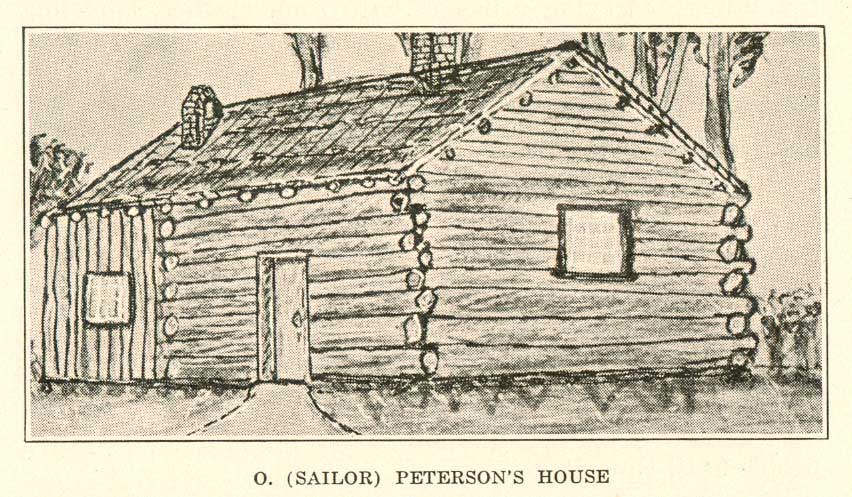
Olaf "Sailor" Peterson's cabin; he would relocate to Stromsburg
Norelius does not detail the churches real estate issue, for his focus is on the Baptist's notorious effects on Pastor Håwkanson. Since he and Hasselquist together received Håwkanson's letter recanting his Baptist "fall", it too has the stamp of authenticity. What it does not have is a clear statement that Håwkanson was indeed immersed in Brush Creek, as all Baptist sources claim. Subsequent Augustana historians have been quick to portray Håwkanson's lapse as only theoretical; seriously considering the move; even parting company with his wife when confronted by Hasselquist on their "meeting on the road to Brush Creek"; but more often than not, Håwkanson "remains dry." The reader is invited to examine the sources and decide. Norelius is "clearly ambiguous."
There is one telling phrase in the recantation letter that reads: "Thanks that You, Brother, did not hastily write to the Synod President and demand my dismissal." The way in which this places Hasselquist as standing before Håwkanson as his advocate, and its prominent publication, suggests that the text might have been jointly scripted to forestall just such a gloomy outcome. Just a thought.
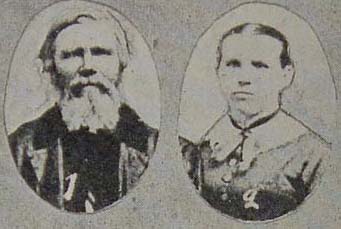
Olaf "Sailor" Peterson and his wife
L.J. Ahlstrom, in his 1933 history of Swedish Baptist work in Iowa, has the following information about Olaf "Sailor" Peterson mentioned above.
"O. Peterson, a deacon in the Lutheran church, is a very interesting person. He came to America 1847, earlier in the season than M.F. Håwkanson who arrived in New Sweden in the Autumn.
Peterson was born Aug. 2, 1807 on the isle of Oland, Kalmar lan, in the Baltic. At an age of twelve went to sea, continuing a seafaring life for eleven years, visiting the West Indies, Australia and New Zealand. For several months his ship was detained at a port in New Zealand for repairs and a new cargo. Here he often attended the meetings of a Methodist missionary who preached in a big tent, and when he expounded John 3:14-16 the young sailor was awakened and began a new life. His captain, a warmhearted Christian, gave him good advice and a New Testament. In 1838 he returned to Stockholm and after that made only occasional trips to the coasts of Finland and Russia. In Helsingfors, Finland, he heard pastor F.G. Hedberg preach a gospel sermon and experienced the full joy of salvation.
In 1841, Peterson married Anna Margret Ekengren. He was engaged as missionary by the American Seamen's Friends Society of New York and worked principally among the sailors in Stockholm, 1841-1847. During this time he came in direct contact with the English Methodist missionary, George Scott, and all the leading separatists in Stockholm, including Pastor Hedberg from Finland. And as F.O. Nilsson was engaged by the same Society, these two men had met in Stockholm and were no strangers to each other when they met at New Sweden. Peterson had introduced the Baptist pioneer, Captain Schroeder, to the most prominent Pietist in Stockholm C.O. Rosenius. Schroeder speaks of O. Peterson in his History of the Swedish Baptists, N.J. Nordstrom in his History of Baptists in Sweden, and J. Bystrom in A Freechurch Pioneeer as a pioneer figure in the new evangelical movement. A. Wiberg also includes Mrs. Peterson as an influential gospel worker. When Peterson in his memoirs mentions the small private prayermeetings in Stockholm with the singer, Oscar Ahnfelt, Dr. Fjellstedt, the Palmquist brothers and others he concludes thus: 'The prayer-hours together with these believers were the most happy moments in my life.' He continued his missionary activites until 1847, 'and then,' he says, 'I decided to leave Sweden in order to get more freedom to worship our God.'
Before they arrived in New Sweden the Petersons were well posted on both the Methodist and the Baptist doctrines, but when pastor Håwkanson was baptized Peterson still opposed this step. When G. Palmquist visited him for the first time here, in October 1851, and told him of his doubts about infant sprinkling as scriptural baptism, Peterson could not agree with him, and he was a charter member and trustee and 'they considered themselves as orthodox Lutherans.' In May 1853 both Palmquist and Wiberg were entertained in the Peterson home. In May the following year, F.O. Nilsson came and the Lutherans expected something extraordinary, but 'he preached in the log house like Palmquist and Wiberg and many wept over their sins.'
On May 22, 1854, both Mr. and Mrs. Peterson were baptized in the same way and at the same place as their pastor, Rev. Håwkanson, but unlike him they did not recant.
Olof Peterson was ordained by an Ecclesiastical Council called by the authority of the Baptist church of New Sweden, Jefferson county, Iowa at the Conference in Rock Island, Ill., June 22, 1859, F.O. Nilsson, Moderator, L.L. Frisk, Clerk."
-It should now be obvious why this piece began with the picture of Brush Creek.
This remarkable narrative connects Peterson with a host of names familiar to the Swedish revival movement, and gives insight into the background of one New Sweden principal to perhaps balance the account of Norelius. In Norelius' own story, he too admits to being awakened by the preaching of the Finn, Hedberg. The emigrant group that Norelius is part of had sought the leadership of A. Wiberg, but was referred to G. Palmquist who fulfilled that position. Neither of these leaders was clearly aligned with the Baptists at that point. Though often in disagreement, these early figures were generally acquainted with one another.
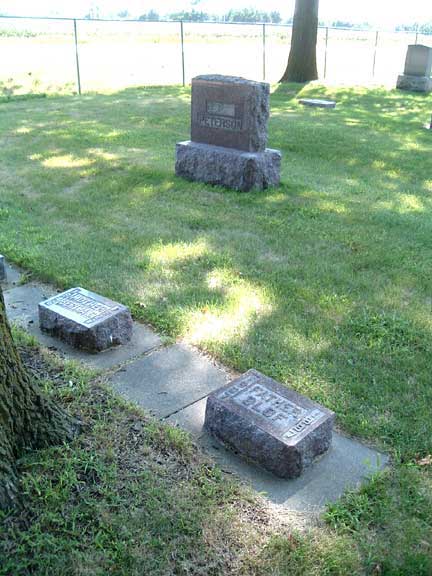
The Olaf Peterson gravesite at Stromsburg
Around 1878 there was a general exodus of Swedish Baptists from New Sweden to Stromsburg, Nebraska, where the availability of better farmland and a strong congregation proved attractive. Most of the New Sweden members pictured in Ahlstrom rest in the Stromsburg cemetery, and it is very intriguing to think that we may be acquainted with their descendants. That has indeed proven to be the case.
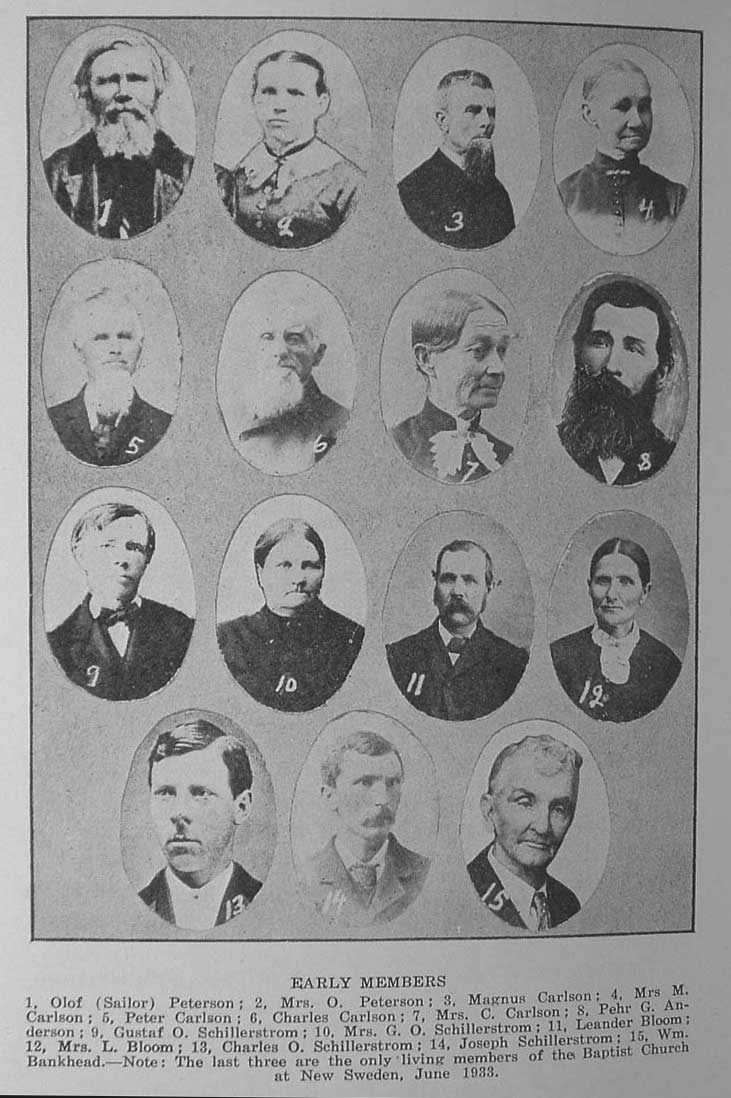
More than half of these New Sweden Baptists are buried at Stromsburg
Baptist pastor Adolf Olson's Centenary History has an interesting account of the Lutheran reaction to the events at New Sweden: quotes from letters written by Gustaf Palmquist.
"...a public notice was read both in Rock Island and Moline, containing a threat to all Swedish Lutherans that if they do not cease to listen to strange and sectarian preachers (referring to me, for no others are located here), they shall be debarred from Holy Communion." "...Bitterness against the Baptists is greatly increasing, and hardly any Lutherans attend my meetings now."
One might ask what Palmquist expected, given the outcomes of his movement. But the final statement is revealing. Apart from his newfound conclusions about New Testament baptism, Palmquist was cut from the same Lutheran cloth as his contemporaries. Did he expect that his followers would somehow peacefully coexist with the Lutherans, on the lines of the mission movement in Sweden? George M. Stephenson, in his definitive book on the immigrant church, speaks with authority as one whose roots are in the New Sweden community. Adolf Olson continues his account, quoting from Stephenson on the reaction of the Methodists to the Baptists: "the Methodists were so zealous in attacking the Baptists that Palmquist was moved to write to O.G. Hedstrom about his brother's (Jonas Hedstrom) unchristian conduct. F.O. Nilsson, Anders Norelius, and others fared no better, according to their own testimony." "Hedstrom stormed and exhorted and sought to appeal to the emotions after the fashion of the frontier revivalist."
It is illuminating that these reactions seemed to take the Baptists by surprise. It is even more illuminating that they are offended by "the fashion of the frontier revivalist", a style most associated with American Baptists from that day till this. Clearly the ethos of the Swedish Baptists was different...something one might call "Lutheran Baptist."
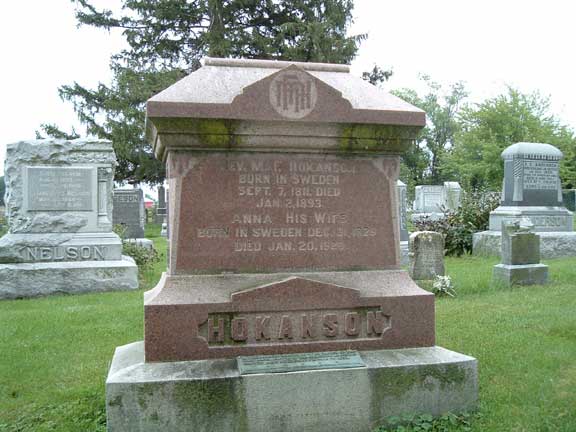
Pastor M.F. Håkanson rests at nearby Munterville
A generation later, immigrant Mission Friends seemed oblivious to the lessons to be learned from the New Sweden days. By then, Hasselquist and the Augustana establishment were understandably determined to resist internal deviations from their practice and polity. Even today, when Covenant descendants sing the song "I have a friend, so patient, kind, forebearing", we may be unaware that it is Palmquist's hymn, and that to some extent we were built on the ground of regenerate membership and the accommodation of believers' baptism staked out by the Swedish Baptists.

It's worth another look. Think of the roster of Swedish immigrant churchmen who found their way to (and in some cases, into) remote Brush Creek and New Sweden: Gustav Unonius, T.N. Hasselquist, Jonas Hedstrom, Gustav Palmquist, Anders Wiberg, F.O. Nilsson and local residents P. Cassel and M.F. Håwkanson. Think of the thousands who made their pilgrimages there in 1931 and 1948. Quite a story indeed.